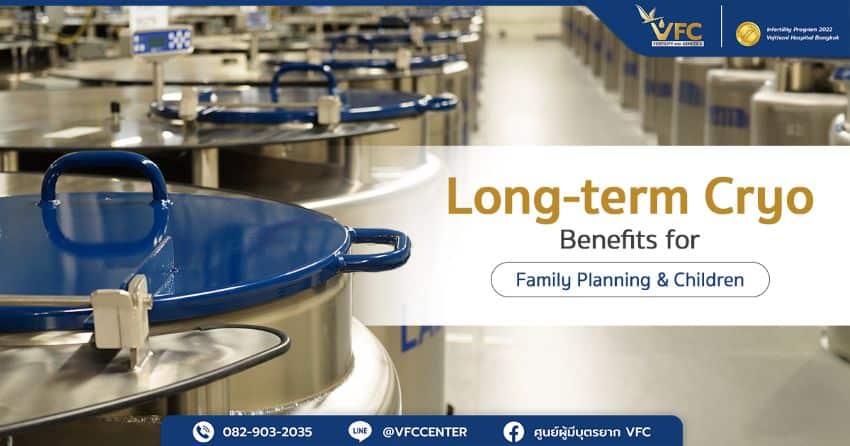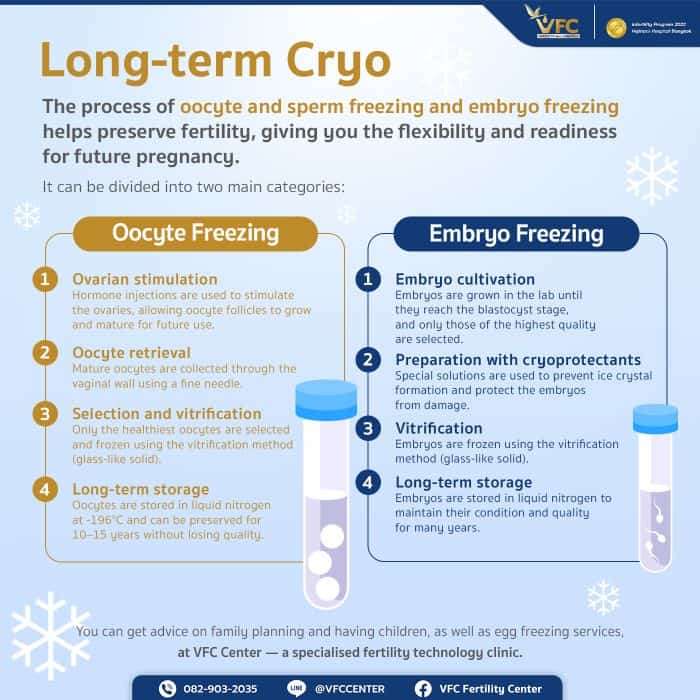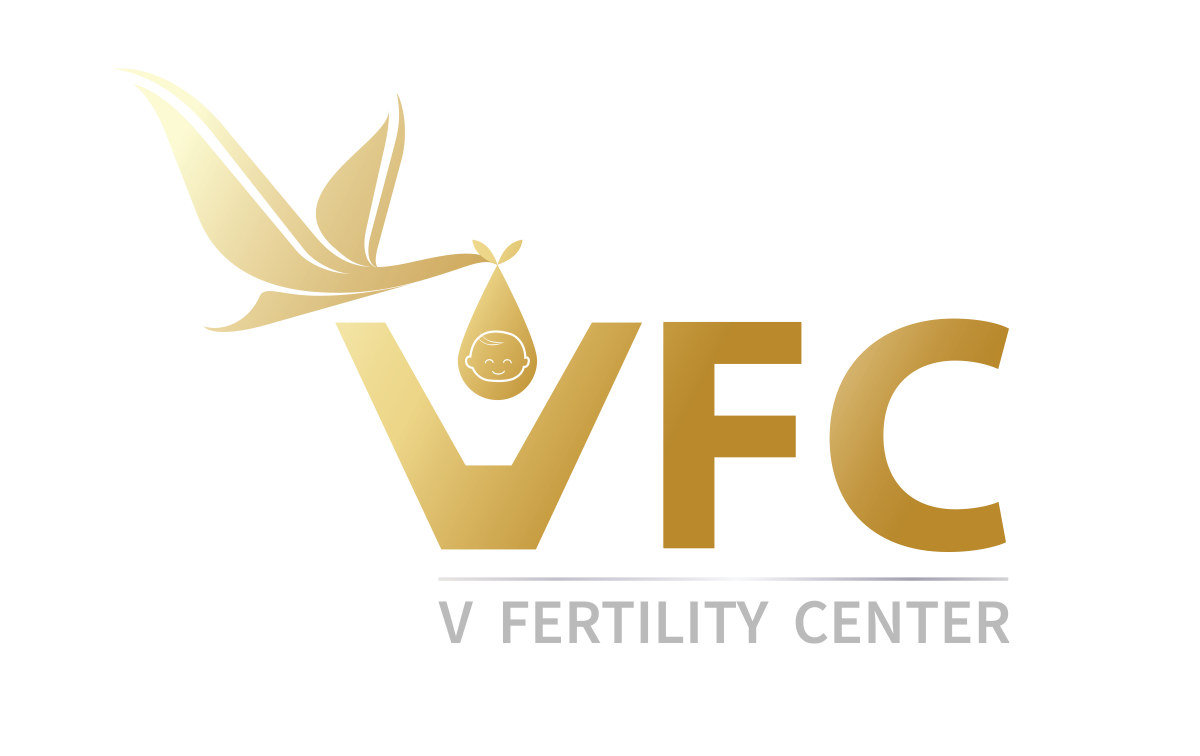
Long‑term Cryo is a breakthrough fertility preservation method that allows couples to take control of family planning and having children. By freezing oocytes or embryos at their healthiest stage, this technology preserves fertility for the future without compromising quality. For those wondering how long eggs can be frozen, modern cryopreservation techniques can safely store them for over a decade, offering flexibility, safety, and peace of mind when planning the right time to start a family.
Many couples choose to approach family planning and having children with careful consideration, taking into account factors such as career stability, financial readiness, and the most suitable time to embrace parenthood. Fertility treatment technologies now play a significant role in helping these plans become reality.
One of the most valuable methods is oocyte and sperm freezing or embryo freezing, known as Long-term Cryo. This technology preserves the quality of oocyte and embryos at their best for future use. When the time comes to have children, it supports a more efficient and safer pregnancy, helping ensure the health and well-being of both mother and baby.
What is Long-term Cryo ?
Long-term Cryo is an advanced medical technique used to freeze reproductive cells — either oocytes or embryos — by lowering them to extremely low subzero temperatures. This halts their biological activity temporarily, while maintaining their ability to develop once thawed.
It is essentially like pressing pause on the biological clock, giving couples the flexibility to decide how long eggs can be frozen and plan for children when the timing is right for them.

How Does Long-term Cryo Work ?
The Long-term Cryo process is divided into two main parts: Oocyte freezing and embryo freezing. Each step is carefully developed to ensure the best possible outcome.
The Oocyte Freezing Process
- The process begins with stimulating the woman’s ovaries. The doctor performs a transvaginal ultrasound and a blood test to assess the number of follicles. Hormone injections are then given for around 9–12 days to stimulate the follicles so they grow and mature for future use.
- Once the oocytes have reached the desired size and quantity, a final injection is given to fully mature them. The oocytes are then retrieved through the vaginal wall using a fine needle under sedation, a procedure that takes about 30–45 minutes.
- The retrieved oocytes are carefully examined, and only the healthiest are frozen using the vitrification method — a rapid cooling technique that prevents ice crystals from forming and damaging the cells.
- Frozen oocytes are stored in liquid nitrogen at around -196°C. For those wondering how long can oocytes be frozen, they can typically be preserved for 10–15 years without losing quality.
When the couple is ready for family planning and having children, the frozen oocytes are thawed and checked for quality. Fertilization is then carried out using ICSI (Intracytoplasmic Sperm Injection) with the highest quality sperm from the male partner.
After fertilization, the resulting embryos are cultured until the blastocyst stage, which usually takes about five days, before being transferred into the uterus to initiate pregnancy.
The Embryo Freezing Process
For couples who are not yet ready for pregnancy, embryo freezing is an option. The main steps are:
- Embryo culture – Embryos are grown in the lab until they reach an optimal stage, such as the blastocyst stage. High-quality embryos are selected for freezing.
- Cryoprotectant preparation – The embryos are treated with cryoprotectants to prevent ice crystal formation and protect them from damage during freezing.
- Vitrification – Embryos are frozen rapidly until the liquid inside the cells becomes a glass-like solid without forming ice crystals that could damage them.
- Long-term storage – Embryos are stored in liquid nitrogen at approximately -196°C, maintaining their condition and quality for many years.
When the time is right for pregnancy, the embryos are carefully thawed and transferred into the woman’s uterus to begin the pregnancy process.

What Are the Benefits of Long-term Cryo ?
Oocyte and sperm freezing or embryo freezing — collectively known as Long-term Cryo — offers many advantages for couples who want to focus on family planning and having children. The most common benefits include:
Preserving Fertility
Many women face factors that can affect the quality and quantity of their oocytes, such as aging, certain medical treatments like chemotherapy for cancer, or illnesses that may impact the ovaries. Long-term Cryo helps preserve fertility by keeping high-quality oocytes or embryos for future use, ensuring readiness for pregnancy when the time is right.
Flexibility in Life Planning
This technology offers couples greater flexibility in planning their lives. Whether you want to prioritise your career, pursue further education, travel, or achieve financial stability before having children, Long-term Cryo allows you to make that choice without feeling pressured. You can preserve your chance of a healthy pregnancy while focusing on other goals first.
Higher Chances of a Successful Pregnancy
Using frozen oocytes or embryos that have been carefully selected for quality can increase the chances of a successful pregnancy, as they are in their optimal condition. This often results in better outcomes compared to oocytes or embryos affected by age or other factors later in life.
That said, while oocytes can be stored for many years, doctors often recommend using them before the woman’s age significantly increases. In general, they suggest using frozen oocytes before the age of 40–45, and ideally not later than 48–50. This is because advanced maternal age can increase the risk of pregnancy complications, such as gestational hypertension, gestational diabetes, and other conditions that may affect both mother and baby.
Now that you know how long oocytes can be frozen and the key benefits of Long-term Cryo, it’s clear that this technology — including oocyte and sperm freezing — can make family planning and having children much easier. For couples who want to undergo ICSI or IVF to conceive at the most suitable time, VFC Center (V Fertility Center) offers personalized consultations and close care at every stage from experienced obstetricians and gynaecologists, making the journey to parenthood more convenient.
Article by DR. Sorramon Songveeratham
For inquiries or to make an appointment:
VFC Center – V-Fertility Center
Hotline: 082-903-2035
LINE Official: @vfccenter

OBSTETRICS AND GYNAECOLOGY-REPRODUCTIVE MEDICINE





No Comments
Sorry, the comment form is closed at this time.